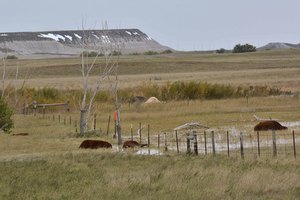
Blizzards

Dead livestock littered the rangeland in western South Dakota after a severe blizzard roared in and caught everyone unprepared in October, 2013.
The woman at Interior, South Dakota's only store/cafe/gas station/auto repair shop was happy to talk about the blizzard that less than a week previous had roared through western South Dakota. October temperatures had dropped from 90 degrees on Monday to below zero by Friday as 60 mph winds drove two to four feet of snow across the wide open Dakota countryside. She gravely indicated that the dead livestock we had seen a mile before town were victims of that storm, suffocated by driven snow. She concluded by telling us that officials estimated that one third of the livestock in the western part of the state had perished.
That pounding South Dakota blizzard ended up being one of the most significant yet under reported stories of 2013. It also brought to mind another storm, this one on January 12, 1888, that ravaged the Dakotas, Montana, Minnesota, Nebraska, Kansas and Texas. It too came on the heels of balmy days, in some places 74 degrees. Parents sent their children to school without their normal winter clothing, unaware that by afternoon, temperatures would plummet, dropping as low as -40°F before midnight.
An estimated four to five feet of snow fell and was propelled by hellish winds. Some teachers wisely held their charges at school to wait out the storm. Others though, dismissed the kids hoping they could find their way home. Dozens of children were hopelessly lost in the whiteout within minutes and suffocated or froze to death. In all, the storm claimed 235 lives, so many of them children that it has evermore been referred to as the Schoolhouse or Children's Blizzard.
That the death toll wasn't considerably higher can only be attributed to the fact that the storm blanketed a huge, but relatively sparsely populated area. A blizzard three months later, now known as the Great Blizzard of 1888, paralyzed a much smaller, but more densely populated area of the East Coast for weeks, killing over 400 people.
A blizzard is not just a big snowstorm. It is characterized by strong and sustained winds of at least 35 mph and lasts for three hours or more. When sustained winds push past 45 mph, temperatures plunge to 10°F or lower and whiteout drops visibility to zero, it is rated as a severe blizzard. How much snow falls isn't really a part of the equation. In fact, it is possible to have a ground blizzard without snowfall when strong winds whip loose snow on the ground into a frenzy.
For a blizzard to form, three things must occur: There needs to be a cold front, moisture laden air, and warm rising air that ascends over the cold air.
Strangely, with a warming climate, these conditions are more likely to occur. Warming bodies of water may release more water vapor and warmer air can accept and hold more water. So, even though the average snowfall may decrease, the probability for severe blizzards may increase.
Blizzards are an awesome reminder that nature is still in charge and we had best respect that. Even the nicest winter day can quickly change into a killer blizzard for the unprepared.

"WOW. What a phenomenal piece you wrote. You are amazing." Jennifer Jackson
That is embarrassing, but actually a fairly typical response to my nature essays. Since The Best of Nature is created from the very best of 16 years of these nature essays published weekly in the Idaho Falls Post Register (online readership 70,000), it is a fine read. It covers a wide variety of topics including humorous glimpses of nature, philosophy, natural history, and conservation. Readers praise the style, breadth of subject matter and my ability to communicate complex and emotional topics in a relaxed and understandable manner.
Everyone can find something to love in this book. From teenagers to octogenarians, from the coffee shop to the school room, these nature essays are widely read and enjoyed.
Some of the essays here are my personal favorites, others seemed to strike a chord with readers. Most have an important message or lesson that will resonate with you. They are written with a goal to simultaneously entertain and educate about the wonderful workings of nature. Some will make you laugh out loud and others will bring a tear to the eye and warm your heart.
Readers Write:
"You hit a home run with your article on, Big Questions in Nature. It should be required reading for everyone who has lost touch with nature...great job!" Joe Chapman
"We enjoyed your column, Bloom Where Planted. Some of the best writing yet. The Post Register is fortunate to have your weekly columns." Lou Griffin.
To read more and to order a copy, click here or get the Kindle version
Copies are also available at:
Post Register
Island Park Builders Supply (upstairs)
Barnes and Noble in Idaho Falls
Harriman State Park, Island Park
Museum of Idaho
Valley Books, Jackson Wyoming
Avocet Corner Bookstore, Bear River National Wildlife Refuge, Brigham City, Utah
Craters of the Moon National Monument Bookstore, Arco, Idaho